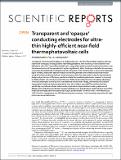Transparent and ‘opaque’ conducting electrodes for ultra-thin highly-efficient near-field thermophotovoltaic cells
Author(s)
Karalis, Aristeidis; Joannopoulos, John
Downloads41598-017-13540-8.pdf (2.458Mb)
PUBLISHER_CC
Publisher with Creative Commons License
Creative Commons Attribution
Terms of use
Metadata
Show full item recordAbstract
Transparent conducting electrodes play a fundamental role in far-field PhotoVoltaic systems, but have never been thoroughly investigated for near-field applications. Here we show, in the context of near-field planar ultra-thin ThermoPhotoVoltaic cells using surface-plasmon-polariton thermal emitters, that the resonant nature of the nanophotonic system significantly alters the design criteria for the necessary conducting front electrode. The traditional ratio of optical-to-DC conductivities is alone not an adequate figure of merit, instead the desired impedance matching between the emitter and absorber modes along with their coupling to the free-carrier resonance of the front electrode are key for optimal device design and performance. Moreover, we demonstrate that conducting electrodes 'opaque' to incoming far-field radiation can, in fact, be used in the near field with decent performance by taking advantage of evanescent photon tunneling from the emitter to the absorber. Finally, we identify and compare appropriate tunable-by-doping materials for front electrodes in near-field ThermoPhotoVoltaics, specifically molybdenum-doped indium oxide, dysprosium-doped cadmium oxide, graphene and diffused semiconductors, but also for 'opaque' electrodes, tin-doped indium oxide and silver nano-films. Predicted estimated performances include output power density ~10 W/cm 2 with > 45% efficiency at 2100 °K emitter temperature and 60 Ω electrode square resistance, thus increasing the promise for high-performance practical devices.
Date issued
2017-10Department
Massachusetts Institute of Technology. Department of Physics; Massachusetts Institute of Technology. Research Laboratory of ElectronicsJournal
Scientific Reports
Publisher
Nature Publishing Group
Citation
Karalis, Aristeidis, and Joannopoulos, J. D. “Transparent and ‘opaque’ Conducting Electrodes for Ultra-Thin Highly-Efficient Near-Field Thermophotovoltaic Cells.” Scientific Reports 7, 1 (October 2017): 14046 © 2017 The Author(s)
Version: Final published version
ISSN
2045-2322